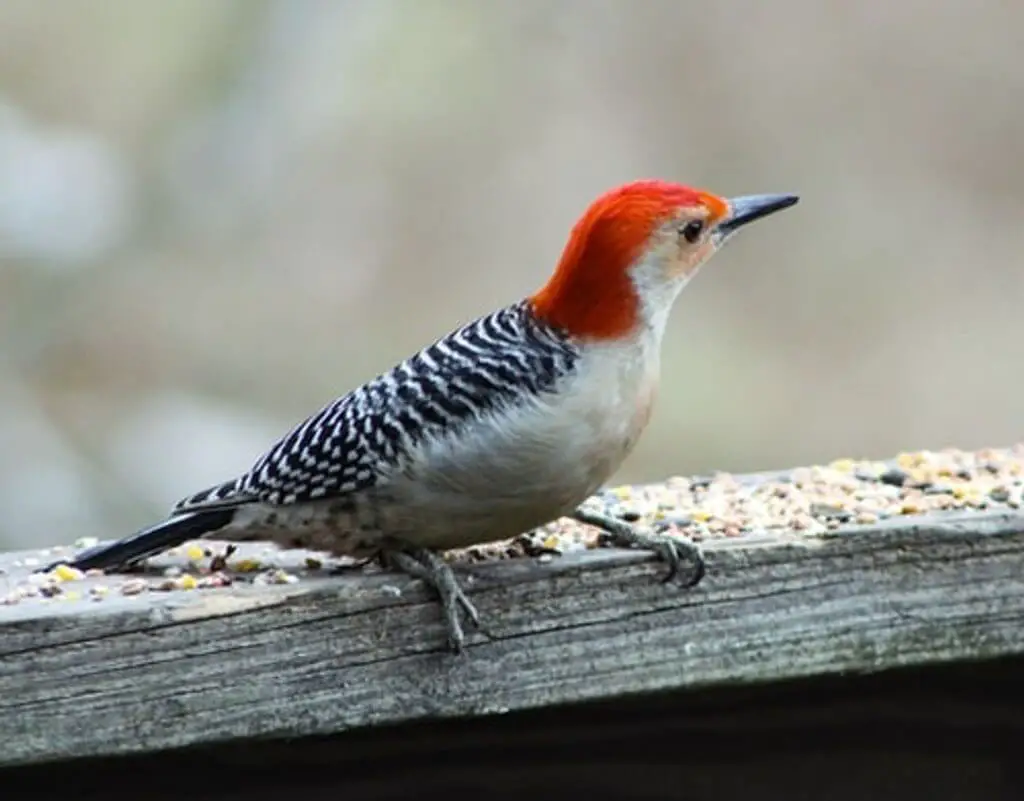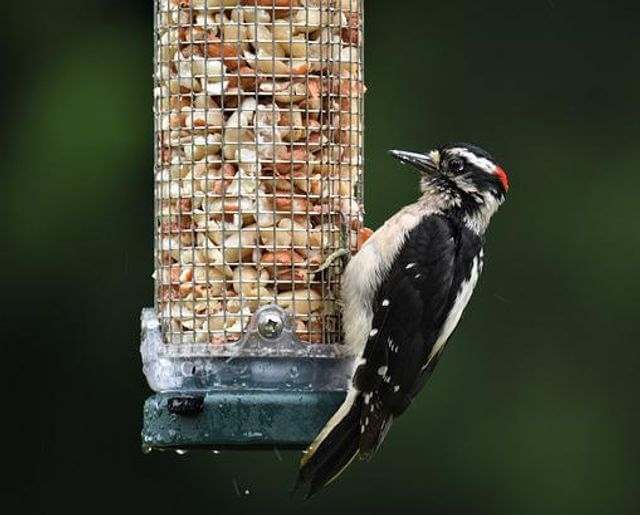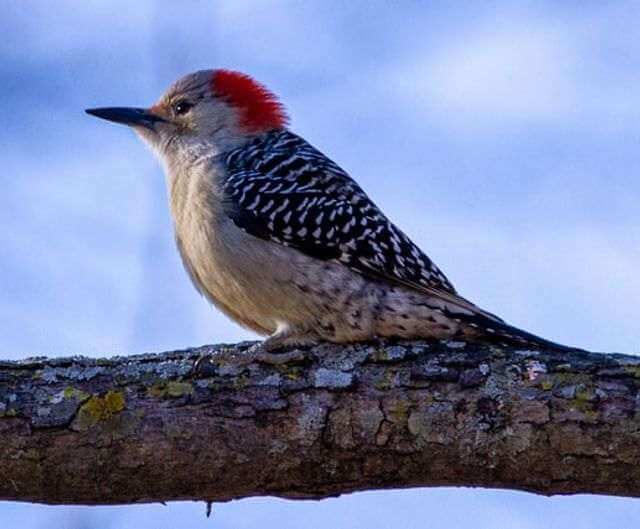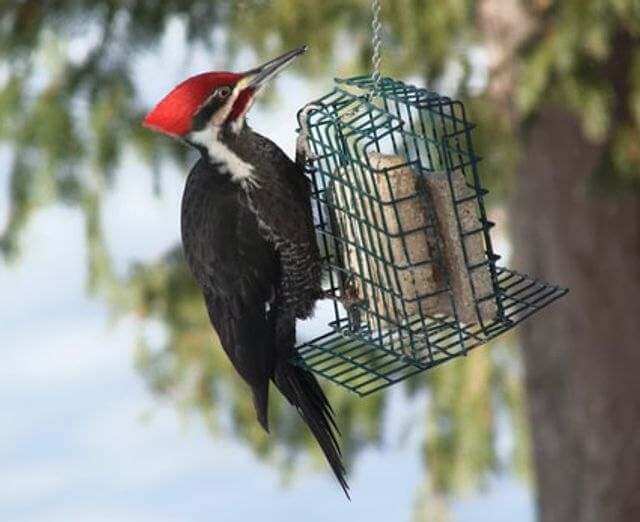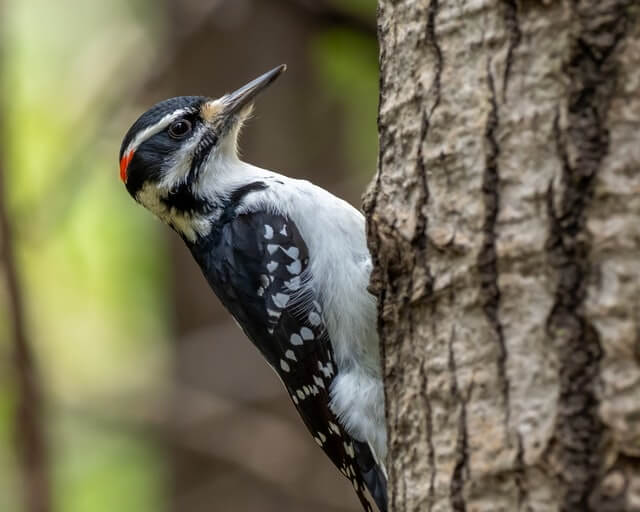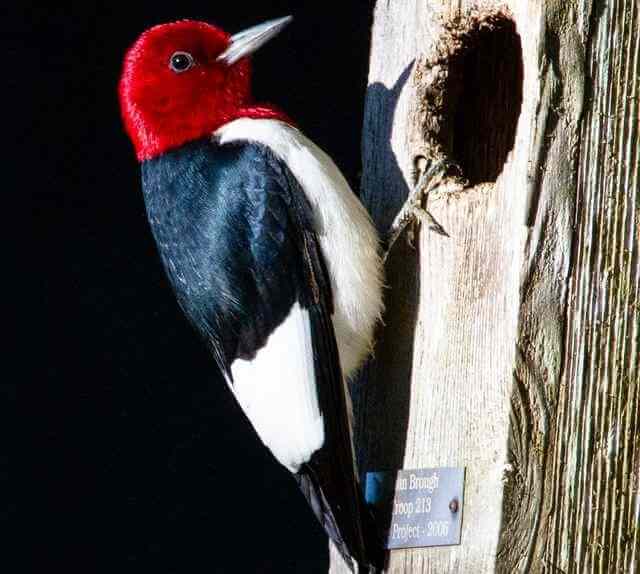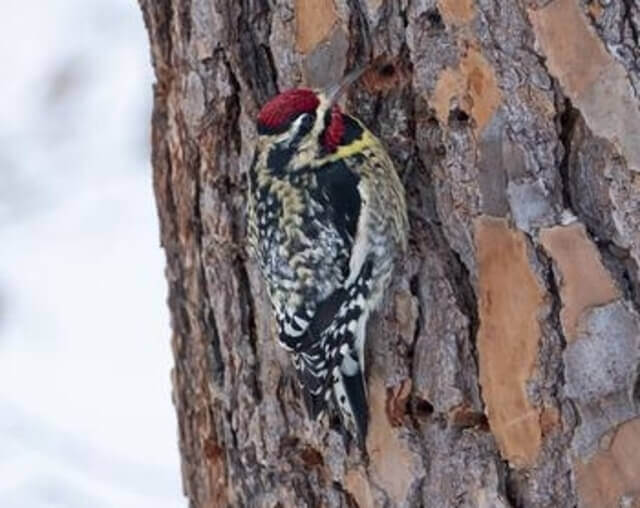Welcome to our comprehensive guide on the 8 types of woodpeckers found in Indiana! Woodpeckers are fascinating birds known for their drumming and pecking behaviors.
In this ultimate guide, we’ll explore the various species of woodpeckers native to Indiana, their unique characteristics, habitats, and behaviors.
Whether you’re a birdwatcher, nature enthusiast, or simply curious about Indiana’s wildlife, this guide is your go-to resource for learning all about these remarkable birds.
Table of Contents
Types of Woodpeckers in Indiana
Downy Woodpecker
- Length: 5.5-6.7 in (14-17 cm)
- Weight: 0.7-1.0 oz. (21-28 g)
- Wingspan: 9.8-11.8 in (25-30 cm)
- Scientific Name: Picoides pubescens
- Frequency of Occurrence: 41.72% (Statistic by: eBird)
- Where To Find Them: In Indiana, they are found in most counties.
- How to Attract: Downy woodpeckers often visit backyard bird feeders, where they can be attracted with a variety of foods, including sunflower seeds, suet, and peanut butter. Downy woodpeckers also like to eat insects, so providing a good source of insect food, such as a bird feeder or a platform feeder filled with live mealworms, can help attract them to your yard. Downy woodpeckers typically prefer large trees for nesting and roosting, so providing a few tall trees in your yard can also help attract them.
Description: The Downy Woodpecker is a small woodpecker that can be seen in North America. They live in forests and woodlands, and can also be found in urban areas. Downy Woodpeckers eat insects, as well as berries and seeds.
The female Downy Woodpecker gathers twigs and leaves in order to build her nest. She lays 3-7 eggs, which she incubates for 12-14 days. The young birds stay with the adults for about a month.
Related Post: How to Attract Downy Woodpeckers to Your Yard? (Easy!)
Red-bellied Woodpecker
- Length: 9.5 in (24 cm)
- Weight: 2.0-3.2 oz. (56-90 g)
- Wingspan: 13.0-16.5 in (33-42 cm)
- Scientific Name: Melanerpes carolinus
- Frequency of Occurrence: 39.28%
- Where To Find Them: In Indiana, they are found in the northern part of the state and along the Ohio River.
- How to Attract: These birds are attracted to dead trees, where they feed on insects, larvae, and spiders. You can attract red-bellied woodpeckers to your yard by providing them with a food source and a place to nest. You can provide a food source for red-bellied woodpeckers by putting out a feeder filled with suet or peanuts. Furthermore, you can also put out a tray of mixed birdseed. Be sure to keep the feeder clean and filled with fresh food daily. Red-bellied woodpeckers will also use nesting boxes if you provide them.
Description: The red-bellied woodpecker is a medium-sized woodpecker found in North America. Red-bellied woodpeckers diet consists mostly of insects, but they will also eat fruits, nuts, and seeds. They inhabit deciduous forests and urban areas throughout most of the United States and southern Canada.
Red-bellied woodpeckers nests are typically found in dead trees or live trees with large cavities. Up to six eggs can be laid in a clutch, and both parents help incubate the eggs and care for the young.
Related Post: How to Attract Red-bellied Woodpeckers to your Yard?
Northern Flicker
- Length: 11.0-12.0 in (28-31 cm)
- Weight: 3.9-5.6 oz. (110-160 g)
- Wingspan: 16.5-20.0 in (42-51 cm)
- Scientific Name: Colaptes auratus
- Frequency of Occurrence: 19.16%
- Where To Find Them: They can be seen in the rural areas, as well as in the cities and suburbs. Some of the most popular spots to see them include Brown County State Park, the Indiana Dunes National Lakeshore, and Fort Harrison State Park.
- How To Attract: Northern flickers love to eat insects, so offer them a feeder that is filled with mealworms, ants, or other small insects. You can also plant trees and shrubs that provide dense cover for nesting and roosting. The northern flicker is a beautiful bird, and it’s sure to bring life to your backyard!
Description: The Northern Flicker is a medium-sized woodpecker that is found in the eastern and central United States. It ranges from southern Canada to Florida, and west to Texas and Oklahoma.
The diet of the Northern Flicker consists mostly of insects, but it also eats fruit and nuts. The habitat of the Northern Flicker includes forests, woodlands, and parks. It nests in tree cavities, sometimes using abandoned nests of other birds.
Related Post: How to Attract Northern Flickers to your Backyard (Easy)
Pileated Woodpecker
- Length: 15.8-19.3 in (40-49 cm)
- Weight: 8.8-12.3 oz. (250-350 g)
- Wingspan: 26.0-29.5 in (66-75 cm)
- Scientific Name: Dryocopus pileatus
- Frequency of Occurrence: 13.69%
- Where To Find Them: The birds are usually seen in the southern half of the state, but have been spotted in all 92 counties. Some of the best spots to see Pileated Woodpeckers in Indiana are: Brown County State Park, Fort Harrison State Park, Prophetstown State Park, and Turkey Run State Park.
- How To Attract: These woodpeckers are attracted to dead trees and other rotting wood, where they forage for insects. If you want to attract these birds to your backyard, you can provide them with a dead tree or log to forage on. You can also install a bird feeder that offers freeze-dried insects, or a suet feeder with insect suet. You can also put up a nesting box for them.
Description: The Pileated Woodpecker is the second largest woodpecker in North America, and can be found throughout the eastern United States and Canada. This woodpecker prefers mature forests with large trees, and feeds on a variety of insects, as well as fruit and nuts.
Pileated Woodpeckers build their nests in large trees, often excavating a tunnel into the trunk or a dead limb. These birds typically lay four to six eggs, and the chicks stay in the nest for about two months.
Related Post: How to Attract Pileated Woodpeckers to your Yard (Fast)
Hairy Woodpecker
- Length: 7.1-10.2 in (18-26 cm)
- Weight: 1.4-3.4 oz. (40-95 g)
- Wingspan: 13.0-16.1 in (33-41 cm)
- Scientific Name: Picoides villosus
- Frequency of Occurrence: 13.09%
- Where To Find Them: Some spots that they are commonly seen include the bottomland forests near the Ohio River and in the Hoosier National Forest. They can also be found in wooded areas near rivers and lakes, as well as in urban settings with plenty of mature trees.
- How To Attract: These birds are attracted to feeders that offer suet, insects, and other small critters. Hairy woodpeckers are attracted to feeders that offer suet, insects, and other small critters. Suet is a high-fat food that these birds love to eat. You can either purchase suet or make your own by mixing fat with bird seed. Be sure to place the feeder where it will be accessible to the woodpeckers. Insects are another favorite food of hairy woodpeckers. You can attract these birds by hanging a hummingbird feeder near your feeder for the woodpeckers to enjoy.
Description: The Hairy Woodpecker is a medium-sized woodpecker that is found in North America. They have a range that extends from Alaska to Mexico, and they are also found in parts of Central America and the Caribbean.
These woodpeckers live in a variety of habitats, including forests, woodlands, and even parks and gardens. Their diet consists mostly of insects, but they will also eat nuts, seeds and fruit. Hairy Woodpeckers build their nests in tree cavities, either natural or man-made.
Red-headed Woodpecker
- Length: 7.5-9.1 in (19-23 cm)
- Weight: 2.0-3.2 oz. (56-91 g)
- Wingspan: 16.5 in (42 cm)
- Scientific Name: Melanerpes erythrocephalus
- Frequency of Occurrence: 8.04%
- Where To Find Them: There are several locations in Indiana where you can spot a red-headed woodpecker. One of the best spots is at Shades State Park, located in the central part of the state. The park is home to a large population of these birds and offers great opportunities for observing them. Another good spot is Yellowwood State Forest, also in the center of the state. This forest is known for its tall hardwood trees, which provide ideal habitat for red-headed woodpeckers. Finally, if you’re near Indianapolis, you can visit Eagle Creek Park, which has a healthy population of these birds as well.
- How to Attract: Red-headed Woodpeckers are a common backyard bird, and they can be attracted to a backyard feeder with the right food. Sunflower seeds are a favorite food of red-headed woodpeckers, but they will also eat suet, peanuts, and insect larvae. A platform feeder or tray feeder is best for feeding red-headed woodpeckers, as they can cling to the sides of the feeder while they eat. A birdbath can also attract red-headed woodpeckers. They will drink from the bath and sometimes bathe in it.
Description: The Red-headed Woodpecker is a medium-sized woodpecker that ranges from Canada to central Mexico. They live in open woodlands, forest edges, and parks. These birds mainly eat insects, but also consume fruits and nuts.
They construct their nests in trees’ cavities, often in hollows that bored woodpeckers once occupied. Up to six eggs are laid and incubated by both parents for about two weeks. The young birds stay with their parents for another two weeks or so.
Related Post: Interesting Red-Headed Woodpecker Facts (Explained)
Yellow-bellied Sapsucker
- Length: 7.1-8.7 in (18-22 cm)
- Weight: 1.5-1.9 oz. (43-55 g)
- Wingspan: 13.4-15.8 in (34-40 cm)
- Frequency of Occurrence: 2.06%
- Where To Find Them: The Yellow-bellied Sapsucker is a migratory bird that is found in many different areas and locations throughout Indiana. During the winter, they can be found in the southern part of the state near Brown County. They are also seen in other parts of Indiana during the summer months. In particular, they are commonly spotted in the northwestern part of the state near Valparaiso and Lake Michigan.
- How to Attract: They like to feed on the sap of trees, and can often be seen at feeders that offer suet or sunflower seeds. A birdbath can also attract these birds, as they like to drink and bathe in water.
Description: The yellow-bellied sapsucker is a North American woodpecker that ranges from Alaska to southern Mexico. They live in a variety of habitats, from the edges of coniferous forests to open woodlands and even orchards and gardens. They eat insects, especially ants and beetles, as well as sap from trees.
They nest in holes in trees, either excavated by the birds or taken over from other hole-nesting birds. The female lays 4-5 eggs, which are incubated by both parents for 12-13 days. The young stay with the parents for another month or two.
Related Post: 16 Interesting Sapsucker Facts Revealed!
Black-backed Woodpecker
- Length: 9.1 in (23 cm)
- Weight: 2.1-3.1 oz. (61-88 g)
- Wingspan: 15.8-16.5 in (40-42 cm)
- Scientific Name: Picoides arcticus
- Frequency of Occurrence: 0.0001%
- Where To Find Them: In Indiana, they are found in the northern part of the state near Lake Michigan and in the southern part of the state near Evansville.
- How to Attract: This woodpecker is attracted to both feeders and birdbaths, so providing both will increase your chances of attracting them. When it comes to feeders, the black-backed woodpecker prefers suet feeders over all others. They will also eat insects, so adding a few live bugs to your feeder will attract them. If you don’t have a suet feeder, you can also offer them nuts or seeds. When it comes to birdbaths, the black-backed woodpecker likes shallow baths that are about 2-3 inches deep. They typically won’t bathe in water that’s deeper than that. You can also add a small branch or perch near the bath to give the birds a place to rest.
Description: The black-backed woodpecker is a medium-sized woodpecker that ranges across North America. They live in forests, woodlands, and parks where they can find a food supply of insects. Black-backed woodpeckers diet consists mostly of insects, but they will also eat fruits and nuts.
These woodpeckers make their homes in old trees, where they drill nesting cavities. Females lay 3 to 5 eggs and both parents help to incubate them and raise the young.
Related Post: Most Common Backyard Birds In Indiana (Explained)

